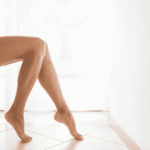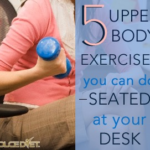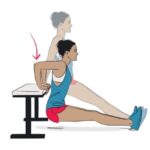“], “filter”: { “nextExceptions”: “img, blockquote, div”, “nextContainsExceptions”: “img, blockquote”} }”>
Get full access to Outside Learn, our online education hub featuring in-depth yoga, fitness, & nutrition courses, when you
>”,”name”:”in-content-cta”,”type”:”link”}}”>sign up for Outside+.
How many of you are willing to jump while wearing white leggings? Giggles followed when I asked this question of a group of ladies, but why? Because we’re not used to discussing pelvic floor health and incontinence in public. But it’s about time for open and honest awareness of how this topic affects so many women — especially athletes — and how pelvic floor exercise can help.
About one in four women experience incontinence (urinary leakage). Younger women tend to experience stress incontinence, which can lead to accidental urine leakage with physical activity like working out. When this happens, white pants for high-intensity workouts are way too revealing! Luckily, targeted exercise can typically improve or resolve this problem.
Many women start with kegel exercises, then feel discouraged due to lack of results. But if kegels aren’t the only solution, what else can women try? The key lies in re-balancing the pelvis.
What is pelvis re-balancing?
Think of the pelvis like a bowl of soup, filled to the brim. If the bowl tips, what happens to the soup? Urinary bladders (even when they aren’t full) are no different. The bladder is housed in the pelvis, which is supported by 36 muscles! All 36 muscles need to work in concert with good flexibility and endurance to keep urine in during workouts and throughout any activity.
Whether you need more flexibility or more endurance tends to correlate with whether you’ve had children.
Female athletes and workout enthusiasts who have not given birth tend to benefit from pelvic floor release and flexibility. Women who have recently been more sedentary, or who have given birth, tend to benefit from pelvic floor endurance exercises. While it’s a good idea to get some kegels in on a daily basis, kegels only target one area, and you may need more exercises to help.
Based on which of the above categories describes you better today, give the following exercises a try:
3 pelvic floor release and flexibility exercises
1. Foam roller sitting
Like other muscles, the pelvic floor can develop trigger points, commonly called “muscle knots.” This creates too much pelvic floor tone, which increases pressure on the bladder. You can decrease this tone by sitting on a short (about 12 inches long) half-cylinder foam roller.
How-to:
- Place a short half foam roller on your chair with the flat side down. Sit on top of the convex side, with the peak of the roller situated between your sit bones.
- If you have trigger points, this is not a comfortable exercise. Breathing will help relax the pelvic floor as you work to increase your tolerance for this type of release work.
Start with 30 seconds at a time, then gradually work up to 2-3 minutes, 2-3 times each day.
3. Butterfly on back
Butterfly on back opens the adductors (inner-thigh muscles); inner-thigh tone greatly impacts pelvic floor pressure. If you want less pressure on the bladder, these muscles need to lengthen.
How-to:
- Begin on your back with your feet together on the floor and knees bent approximately 90 degrees.
- Open your knees away from each other into a butterfly position.
Hold the position for 4 sets of 30 seconds as you relax into the pose.
3. Figure-4 stretch
The glutes and piriformis are essential pelvic floor muscles. If they are not equally flexible on your left and right sides, they contribute to pelvic floor imbalances. You can equalize them with daily figure 4 stretching.
How-to:
- Lie on your back with your knees bent to 90 degrees.
- Cross the ankle of one foot onto your other thigh.
- Intensify the stretch by using your hands or a stretch strap to hug the figure 4 shape in toward your chest.
Hold the figure 4 stretch position for 4 sets of 30 seconds on each side.
3 pelvic floor endurance exercises beyond kegels
1. Band-and-ball hip bridges
The glutes need to cooperate with the inner-thigh muscles and the deep hip rotators to properly support the backside of the pelvic floor. While many women do squats and lunges to build glute strength, the fine-tuned coordination is missing. Bandand-ball hip bridges can help resolve this muscle coordination gap.
How-to:
- Place a stretchy glute band just above your knees. The band should be slightly shorter than the length of your forearm, and moderately stretchy. Heavier bands are not better because they may lead to compensation with other muscles, which would bypass your pelvic floor goal of performing this exercise.
- With the band still above your knees, lie on your back with your knees bent to 90 degrees.
- Before you move, keep your pelvis neutral and actively squeeze your glutes. Try not to tuck your tailbone.
- Gently push your knees out slightly into the band. Allow the band to stretch 1-2 inches — more force is not better.
- Keeping your glutes engaged, use them to raise your hips off the floor any amount.
Hold this bridge position for 4 sets of 30 seconds.
Remove the band, then repeat the entire process with a small soccer-size ball between your knees. With the ball, gently squeeze the knees in while performing a kegel, as opposed to pressing out into a band.
2. Plie squats
Plie squats engage the deep pelvic floor rotators, inner thighs and glutes at different angles to support your pelvic floor. Even if you do the bridge exercise, include this one too! Different angles of strength offer more pelvic floor support.
How-to:
- Stand with feet about twice your shoulder-width apart.
- Turn your toes outward approximately 45 degrees.
- At all times, keep your knees in line with your toes (so they don’t cave inwards).
- Place your hands on your hips.
- Lower down into this turned out squat motion. Only go as low as you can without your knees caving in. Even if you are flexible, consider 90 degrees to be the lowest position.
- Do a kegel and squeeze your glutes as you hold the down part of the motion for 5-10 seconds.
Work up to 3 sets of 20 repetitions.
3. Standing cable adduction
The inner-thigh muscles work in close concert with the pelvic floor muscles to provide pelvic floor support. In the case of incontinence, they benefit from specific endurance-building exercises to help stabilize the pelvic floor. Standing cable adduction offers a great endurance building exercise, with success lying in the details that follow:
How-to:
- Use a light resistance band or cable machine set on a low weight (i.e. 1-2 plates on the stack). If you need something to hang onto for balance, put a sturdy chair about six feet away from your band’s or cable’s anchor point.
- Anchor the band or cable’s cuff around the ankle that is closest to the machine.
- Take two sideways steps away from the machine to allow the cable or band to move. Use one hand for support on the chair’s back if needed.
- Keep your pelvis level as you move. Perform a kegel and engage your abdominal core muscles to initiate the movement.
- Maintaining good kegel and abdominal activation, draw the leg with the cable attached closer to your standing leg. It is OK if you need to touch your foot down to maintain stability.
- If you find your pelvis tipping, or loss of muscle engagement, lighten the load.
Work up to 3 sets of 20.
Next steps
Pelvic floor re-balancing to improve urinary continence takes consistency. Begin with the three exercises in the category that best describe your body’s starting point today. Take it to the next level by consciously incorporating these muscles as you perform other exercises in the gym. For example, if you want to jump rope, engage the same muscles you engaged on the cable adduction exercise while you jump rope.
If you are not seeing improvement after 6 weeks of dedicated effort most days of the week, consider consulting with your gynecologist for individual evaluation. Individualization beyond the basics may be your key.
Finally, before you go, share this article with another woman who might feel the same way about working out in white leggings.













![[keyword]](https://librareview.com/wp-content/uploads/2024/02/education-5517017_960_720-150x150.jpg)








